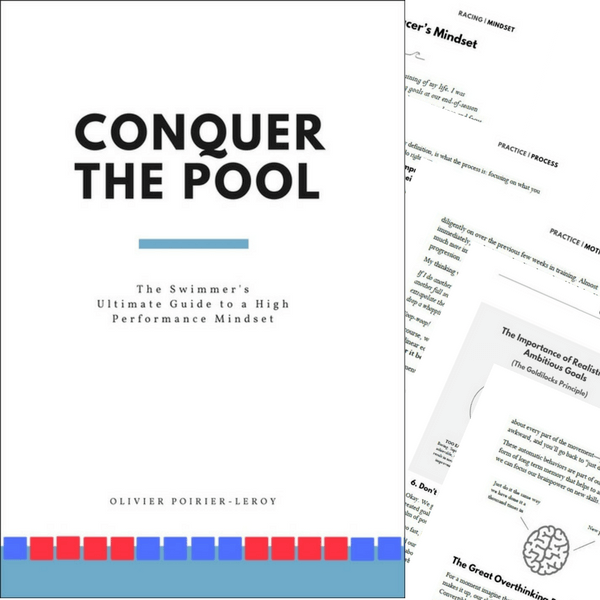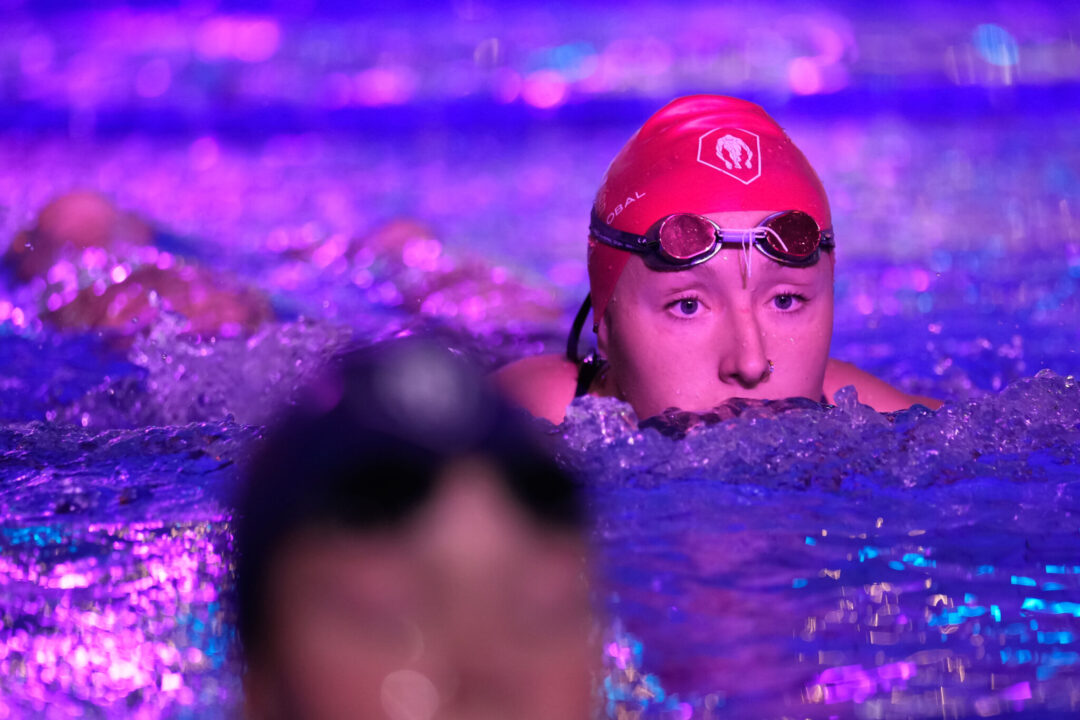Bad swim races happen to us all. Here are some elite tips for rebounding after a poor performance in the water.
One of the key characteristics of elite swimmers is their ability to bounce back after a disappointing performance in competition.
A lot of things that we don’t want to happen after the shave down, taper, and the first warm-up of the meet can include:
- False start our best event in finals on day one of the meet
- Slip off the blocks during our backstroke start, leaving us half a body length behind when we break out
- Our swimming goggles, or worse, swimsuit, incur a malfunction when we dive into the water
- We add time in an important event, shattering expectations for the meet
- We lose badly to a competitor that we typically beat in competition
- Our stroke feels way off, and we struggle to finish a race in a time that is remotely close to our best time
And down the black line we go.
Bad races can haunt us for the rest of the swim meet, leading to more bad races and even bleed into training in the weeks ahead.
Setbacks, or in this case, a bad swim race are going to happen at some point in your career or season. As reliable as clapping hands with another swimmer when the whole lane wears swim paddles and does butterfly in practice.
But having a plan to bounce back is crucial to get back on the proverbial horse and help you salvage the rest of the meet.
In this article, we’ll look at some tried-and-proven strategies for rebounding like a boss after a bad swim race.
Let’s dive in and tell that pushing-off-ten-seconds-early bad swim what’s what:
Get feedback from Coach.
Step one: Talk to your coach. Get his or her feedback on your race. Your coach’s detached perspective will give you clues about what happened so that you smartly move forward.
I get it; you’ll want to go to the warm-down pool and not talk to anyone. Or head straight for the hot tub.
But catch your breath, steady your composure, and go get the 411 from the person who probably knows your swimming better than you (and is best positioned to give you highly actionable feedback on the next steps).
You’d be surprised how different a swim performance looks from the outside compared to how we experience it in the water, and your coach will have insights to help you reset and refocus.
Wear your analytics cap.
Look at how you performed in terms of how you executed the race. Not how you felt about the race.
The things that you did well and more importantly for a quick course-correct, where things didn’t go according to plan.
Doing so can help you diagnose where things fall apart.
- Was your stroke rate too high on the first lap because you were way too excited?
- Did you find yourself mentally drifting during the race, focusing on the position of other swimmers instead of maximizing your own effort?
- Did you stick to your designated race plan? Or did you abandon it once you started focusing on other swimmers or how you felt in the water?
- Were you too excited/nervous or not excited/nervous enough?
An honest self-assessment can be challenging in the heat of the moment, but being able to quickly assess where your race got away from you, and what you can focus on improving next race, is immeasurable.
Elite swimmers learn from their bad swims, and being able to objectively look under the hood of your race and discern where you can improve is a very powerful skill.
(Fun bonus fact: Clear-headed reflection also gives you a head-start on understanding what you need to focus on in training to take your swimming to the next level.)
Dwelling vs Reflecting.
It’s natural to reflect on your swim, especially a bad one, because we seem to relish the opportunity to mentally pile on with all of our doubts and uncertainties.
Stuff like:
- “See, I’m not good enough to swim well.”
- “I’ll never be successful at this sport.”
- “My swimming smells worse than that old drag suit that’s been rotting under the bleachers since the mid-2000s.”
There is a huge difference between dwelling and reflecting. When we dwell, it tends to be a negatively framed emotional appraisal that taints future efforts.
Reflections tend to be more strategic and technical, which gives us something to work with moving forward.
Journal it out.
A reflection strategy that I love with swimmers, groups, and teams that I work with is journaling.
There are lots of benefits of journaling as it relates to competitive swimmers, including gaining a deeper understanding of your performance in the water and chronicling the story of your journey in the pool.
But journaling as a form of reflection after a bad swim can help you “flush” the bad swim so that you can reset and move on. Of course, the previous principle of “reflection” not “dwelling” applies here, too.
Journaling is also an excellent tool for creating distance between yourself and the race; writing clarifies what happened and helps you remove some of the emotions that can cloud judgment and appraisal of what happened during the race.
Ground yourself.
The heat and emotion after a bad swim can run really hot. Hotter than doing a threshold set in a hot tub with a neoprene swim cap strapped to your head.
In these moments, we may not always make the smart decisions that will power future performances. Or we will get really down on ourselves, beating ourselves up.
Grounding yourself—reminding yourself that you are more than a swimmer—can be an excellent tool for swimmers who struggle to recover from a poor performance.
Touch base with your family and friends. Remind yourself that there is life outside of sport. Detach mentally with a book or a movie to help reset.
Doing so can give you the perspective necessary to let go of that bad swim and move forward.
Get back into your competition preparation.
A bad swim or bad session isn’t a reason to abandon your standard method of preparation.
I get it; you are choked and are (momentarily but understandably) feeling like all that hard work you did in training was a tightly packed chlorine puck of wasted time.
That said, it’s time to hit reset, wipe the mental slate clean, and get back into the swing of your race prep.
Whether that means warming down after the swim, warming up for the next race, fueling for performance, doing your regular visualization work, or cheering on your teammates, stick to your plan for the swim meet.
Use it as energy.
A lot of swimmers hate to lose more than they love to win. In other words, the emotional fuel from losing to a competitor or underperforming turns into weapons-grade plutonium forms of energy.
Michael Phelps was legendary for this. His idol, the greatest of all time on the basketball court, Michael Jordan was built much the same (e.g. “I took that personally.”)
Turn that bad swim into a chip on your shoulder. Frame yourself as the underdog.
Use the negative emotion pulsing through your veins for positive effort.
Elite-minded swimmers use everything as fuel, whether that’s a gold medal swim or in this case, a crapola swim.
Wrapping Things Up
Ultimately, in the pool, everything is a lesson and everything can be used as fuel.
- Good swim? Learn from it. Bad swim? Learn from it.
- Good swim? Come back with unmatched effort and focus. Bad swim? Come back with unmatched effort and focus.
This brings us back to the point made at the beginning of the article.
Every swimmer has experienced a what in the fresh, chlorinated hell was that-type of swim in competition. Often in front of millions on our sport’s biggest stage.
The good news is that you aren’t alone in experiencing this.
The better news is now you have the tools to make that bad swim the best thing to ever happen to your swimming.
ABOUT OLIVIER POIRIER-LEROY
Olivier Poirier-Leroy is a former national-level swimmer, author, swim coach, and certified personal trainer. He’s the author of YourSwimBook, a ten-month logbook for competitive swimmers.
 He’s also the author of the recently published mental training workbook for competitive swimmers, Conquer the Pool: The Swimmer’s Ultimate Guide to a High-Performance Mindset.
He’s also the author of the recently published mental training workbook for competitive swimmers, Conquer the Pool: The Swimmer’s Ultimate Guide to a High-Performance Mindset.
It combines sport psychology research, worksheets, anecdotes, and examples of Olympians past and present to give swimmers everything they need to conquer the mental side of the sport.
Ready to take your mindset to the next level in the pool?
Click here to learn more about Conquer the Pool.

It was way easier to simply “not care.” It’s for fun, it’s not a job like being an engineer. The less I cared the faster I got. Athletes get in their own head and way too much. Just have fun.
I don’t think it’s fair to use an iconic swimmer for the cover photo when she had such an illustrious career and when out on a *not so high* note 🙁
Agree with everything in the article. If a swimmer is still down on themselves, I say, “If you dropped time every time, you would eventually go a 1 second 50 freestyle.”
I’ve heard doing katsu and eating vacuum sealed unseasoned pork are optimal forms of recovery
Just listen to Coach Peter Andrew on this one and just do the same exact thing you did before but take a little bit of yardage off
Works every time